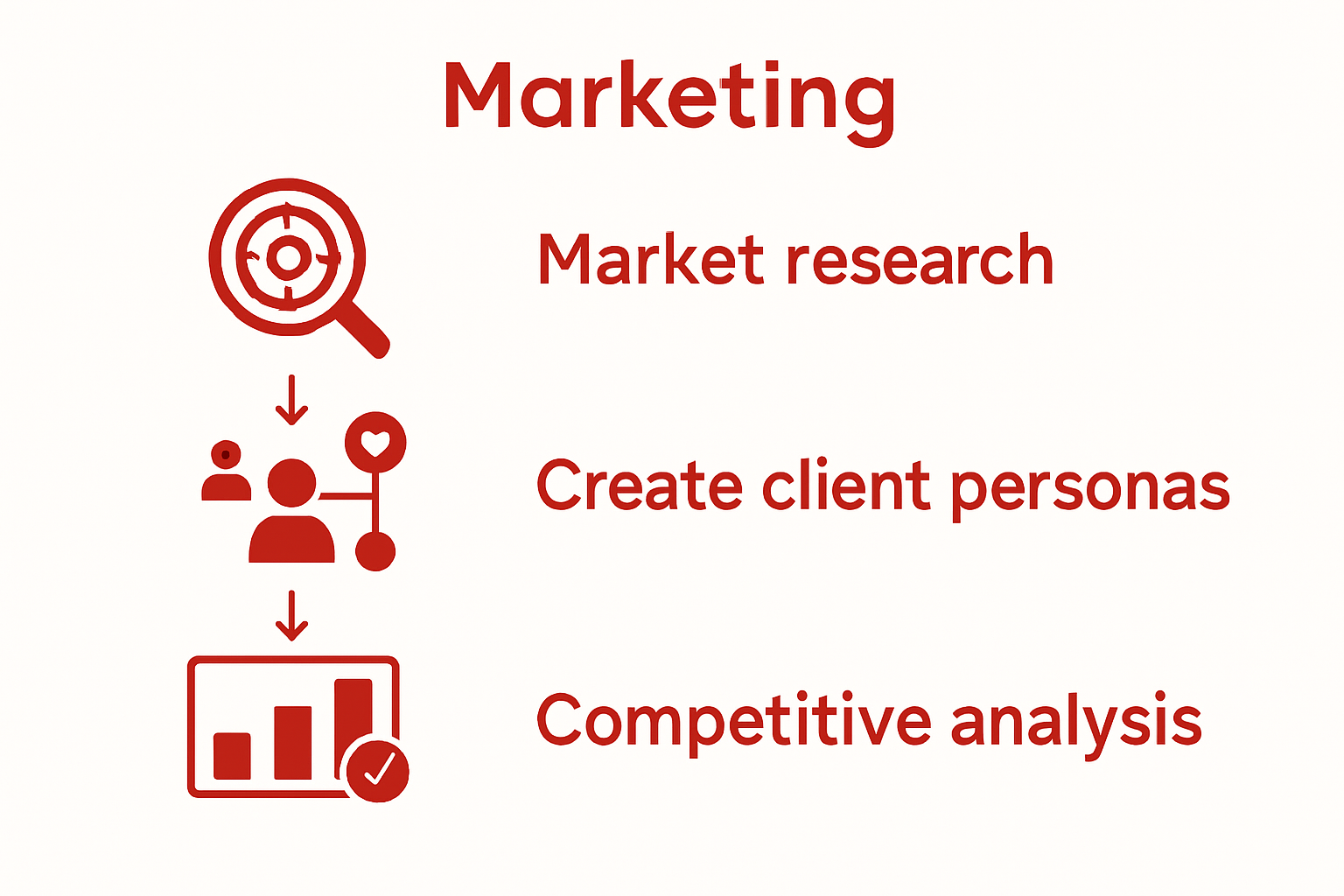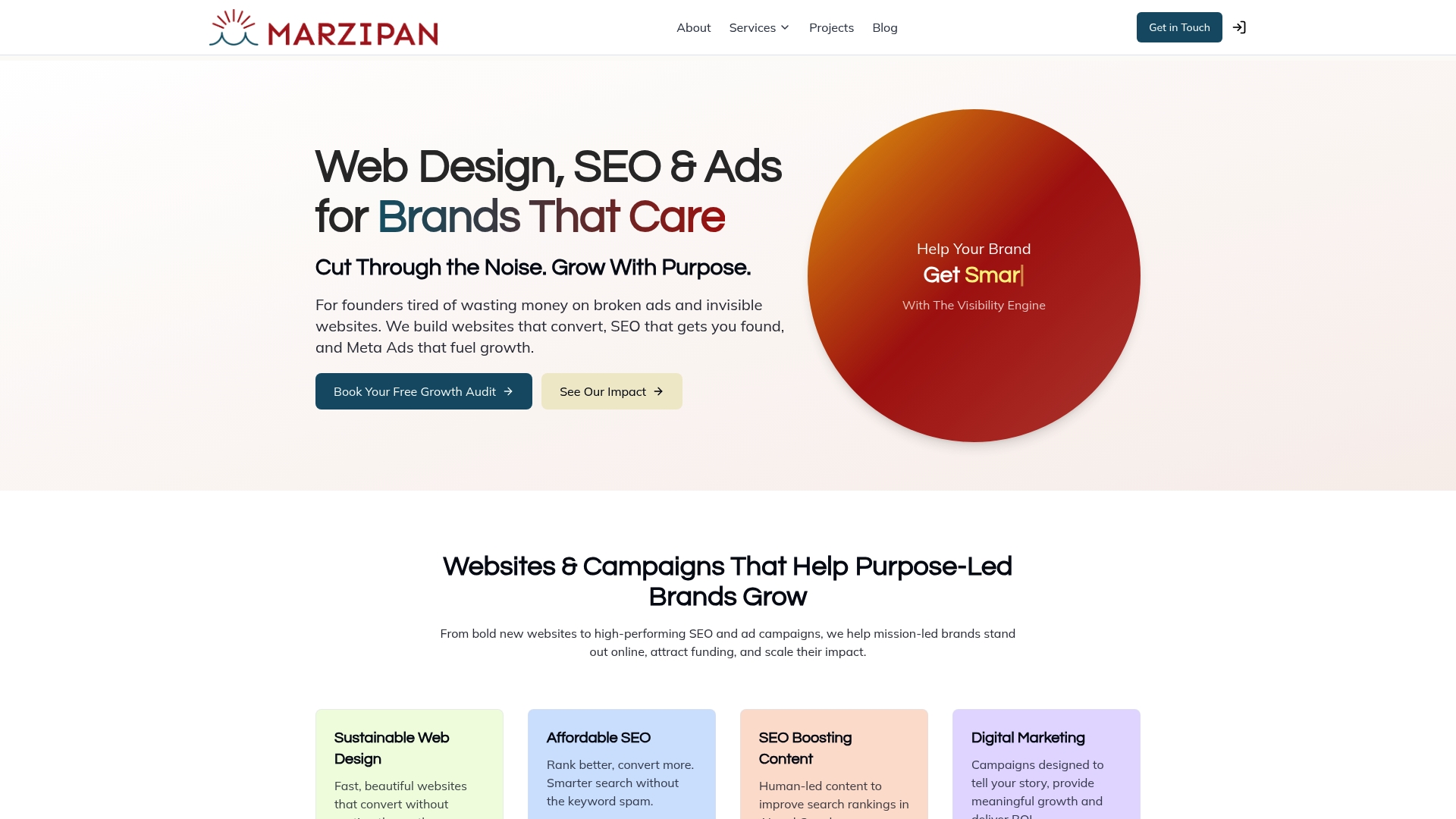How to Start a Web Design Agency: A Step-by-Step Guide
Starting a web design agency can feel overwhelming with so many agencies already out there. Yet, only around 20 percent of new Australian businesses survive past their first five years. You might think the odds are stacked against you. Actually, the real secret is not luck or fancy tech—it comes down to choosing the right niche, planning carefully, and mastering a few strategic steps most beginners completely overlook.
Table of Contents
- Step 1: Identify Your Niche And Target Market
- Step 2: Develop A Business Plan And Strategy
- Step 3: Register Your Business And Obtain Licensing
- Step 4: Build Your Portfolio And Online Presence
- Step 5: Market Your Services And Attract Clients
- Step 6: Establish Client Relationships And Manage Projects
Quick Summary
| Key Point | Explanation |
|---|---|
| 1. Identify Your Niche Clearly | Research to find a market segment that matches your skills and passion. This will help differentiate your agency. |
| 2. Develop a Comprehensive Business Plan | Outline your services, financial projections, and marketing strategies clearly to guide your agency’s growth. |
| 3. Register Your Business Legally | Choose a suitable business structure and obtain necessary licenses, including an Australian Business Number (ABN), to operate professionally. |
| 4. Create a Compelling Portfolio | Showcase your best work strategically to demonstrate your skills and attract potential clients through your agency website. |
| 5. Establish Strong Client Relationships | Implement processes for onboarding, communication, and project management to ensure client satisfaction and repeat business. |
Step 1: Identify Your Niche and Target Market
Launching a successful web design agency starts with pinpointing precisely who you will serve and what unique value you bring to the marketplace. Understanding your specific market segment allows you to craft targeted services that differentiate you from generic web design providers.
Begin by conducting thorough market research to discover potential specialisations within web design. Consider industry verticals where your skills and experience align most closely. Some promising niches might include small professional services like legal practices, healthcare clinics, creative businesses, or specific sectors such as hospitality, e-commerce, or nonprofit organisations. Your goal is identifying areas where you can offer exceptional expertise and solve distinctive design challenges.
Market research from the Australian Business Council suggests developing comprehensive customer personas to understand your potential clients deeply. These personas should encompass key demographic details, professional challenges, technological requirements, and design preferences. By creating detailed profiles, you can tailor your service offerings and marketing approach precisely.
Realistic market assessment requires honest evaluation of your current capabilities and genuine passion. Selecting a niche where you possess genuine technical skills and authentic interest will sustain your motivation during challenging business periods. Reflect on your professional background, previous project experiences, and personal design strengths to determine your most compelling market positioning.
Successful niche selection involves balancing three critical factors: market demand, your competitive advantage, and potential profitability. Research local and national market trends, analyse competitor offerings, and determine service gaps you can uniquely fill. A well-chosen niche transforms your web design agency from a generic service provider into a specialised solution provider that commands premium pricing and attracts ideal clients.

Verify your niche selection by answering these key questions:
- Can you articulate your unique value proposition within this market segment?
- Do potential clients in this niche have demonstrated need for specialised web design?
- Are you genuinely passionate about serving this specific market?
Taking time to methodically define your target market sets a solid foundation for your web design agency’s strategic growth and long-term success.
Step 2: Develop a Business Plan and Strategy
Crafting a robust business plan transforms your web design agency from a conceptual idea into a structured, actionable venture. This critical document serves as both a roadmap and a strategic tool for guiding your business decisions, attracting potential investors, and maintaining clear operational focus.
Begin by outlining your agency’s core business model with precision. Detail your service offerings, pricing structure, and unique value proposition. Consider the specific web design services you will provide: are you focusing on responsive design, e-commerce platforms, WordPress development, or custom web applications? Your business plan should articulate these specialisations clearly and demonstrate how they address market needs.
According to the Australian Government’s business planning resources, a comprehensive business plan must include several key components. Financial projections are paramount. Calculate your startup costs, including equipment, software subscriptions, marketing expenses, and initial operational overheads. Develop realistic revenue forecasts based on your target market research, projected client acquisition rates, and average project values.
Your strategic planning must encompass more than financial spreadsheets. Define your agency’s operational framework, including workflow processes, project management methodologies, and client communication protocols. Establish clear standards for client onboarding, design iterations, project timelines, and post-launch support. These systematic approaches will distinguish your agency as professional and reliable.
Marketing strategy represents another crucial aspect of your business plan. Outline your approach to client acquisition, including digital marketing tactics, networking strategies, potential referral programmes, and content marketing initiatives. Determine how you will leverage platforms like LinkedIn, industry conferences, and local business networks to build your agency’s reputation and attract ideal clients.
Verify your business plan’s effectiveness by ensuring it addresses these fundamental questions:
- Does the plan articulate a clear path to profitability?
- Have you identified potential risks and mitigation strategies?
- Can the plan withstand critical external review?
Remember that a business plan is a living document. Schedule regular reviews and be prepared to adapt your strategy as market conditions evolve and your agency grows.
Step 3: Register Your Business and Obtain Licensing
Transforming your web design agency from a concept into a legitimate business requires navigating the legal landscape of business registration and licensing. This critical step establishes your agency’s official status, provides legal protection, and enables you to operate professionally in the marketplace.
The first substantial task involves selecting an appropriate business structure. Web design agencies typically choose between sole proprietorship, partnership, or limited company registration. Each structure carries distinct legal and tax implications. A limited company structure often provides the most comprehensive personal asset protection and professional credibility, which can be particularly advantageous when attracting corporate clients.
The Australian Business Licence and Information Service recommends obtaining an Australian Business Number (ABN) as a fundamental requirement. This unique identifier allows you to conduct business, register for taxation purposes, and interact with government agencies. The registration process can be completed online through the official government business registration portal, requiring basic information about your business, its structure, and primary activities.
Beyond basic registration, web design agencies must consider additional professional requirements. This includes acquiring relevant professional indemnity insurance, which protects your business against potential legal claims arising from professional services. Research industry-specific insurance options that cover digital service providers, ensuring comprehensive protection for your emerging agency.
Tax registration represents another crucial component of your legal establishment. You will need to register for Goods and Services Tax (GST) if your projected annual turnover exceeds the statutory threshold. Additionally, set up proper accounting systems to track income, expenses, and potential tax obligations. Consider consulting with a professional accountant who understands the nuanced financial landscape of digital service businesses.
Verify your business registration by confirming you have completed these essential steps:
- Obtained an Australian Business Number (ABN)
- Selected and registered an appropriate business structure
- Secured necessary professional insurance
- Established proper tax registration
Careful attention to these legal foundations will provide a solid framework for your web design agency’s future growth and professional credibility.
Below is a checklist table outlining the key legal and administrative requirements for registering your web design agency, as mentioned in the article.
| Requirement | Description | Completion Status |
|---|---|---|
| Australian Business Number (ABN) | Register your agency for an ABN to legally conduct business and interact with government agencies. | To be completed |
| Business Structure Registration | Select and register the most appropriate structure (sole trader, partnership, limited company) for legal and tax purposes. | To be completed |
| Professional Indemnity Insurance | Obtain professional indemnity insurance to protect against claims related to your web design services. | To be completed |
| Tax Registration | Register for GST (if required) and set up accounting systems to manage tax obligations. | To be completed |
| Compliance with Local Licences | Verify any additional licences or permissions required for digital service providers within your location. | To be completed |
Step 4: Build Your Portfolio and Online Presence
Creating a compelling portfolio and establishing a robust online presence are essential steps in positioning your web design agency as a credible and professional service provider. Your digital showcase will serve as a powerful marketing tool, demonstrating your technical skills, creative capabilities, and unique design approach to potential clients.
Start by curating a strategic selection of projects that showcase your range and expertise. Even if you are beginning with limited professional experience, include personal projects, academic work, or pro bono designs that highlight your technical proficiency and creative problem solving. Each portfolio piece should tell a story about your design process, challenges overcome, and the specific solutions you delivered.
Research from digital portfolio experts suggests adopting a reflective approach when presenting your work. Do not simply display images but provide context about each project. Explain the client’s objectives, your design strategy, technical implementations, and the measurable outcomes achieved. This narrative approach transforms your portfolio from a static image gallery into a dynamic demonstration of your professional capabilities.
Your agency website serves as the primary platform for presenting your portfolio. Invest time in creating a responsive, intuitive design that reflects your design philosophy and technical skills. Ensure the website functions flawlessly across different devices and browsers, as this serves as a direct demonstration of your web design expertise. Choose a clean, modern layout that allows your project work to take centre stage, with clear navigation and concise, engaging project descriptions.
Beyond your website, establish a strategic presence on professional networking platforms. Create comprehensive profiles on LinkedIn, showcasing your agency’s services, team expertise, and professional achievements. Engage with design communities, share insights, and participate in relevant online discussions to build visibility and credibility within the web design ecosystem.
Verify the effectiveness of your portfolio and online presence by assessing these key criteria:
- Does your portfolio clearly communicate your unique design approach?
- Are project descriptions informative and demonstrate problem solving skills?
- Does your online presence reflect the professional standard of your web design agency?
Remember that your portfolio is a living document. Continuously update it with new projects, refine your presentation, and ensure it evolves alongside your agency’s growing capabilities.
Here is a table summarising key verification steps to ensure your portfolio and online presence effectively showcase your web design agency.
| Verification Criteria | Questions to Assess | Status |
|---|---|---|
| Unique Design Approach Communicated | Does your portfolio clearly communicate your unique design style and strengths? | To be reviewed |
| Informative Project Descriptions | Do project descriptions provide context, explain challenges, and showcase solutions? | To be reviewed |
| Professional Online Presence | Is your website and LinkedIn profile polished and reflective of agency standards? | To be reviewed |
| Regular Portfolio Updates | Is your portfolio routinely updated with recent, high-quality work? | To be reviewed |

Step 5: Market Your Services and Attract Clients
Successful marketing transforms your web design agency from a concept into a thriving business by systematically attracting and converting potential clients. This critical step requires a strategic approach that combines digital marketing techniques, professional networking, and targeted outreach.
Begin by developing a comprehensive digital marketing strategy that leverages multiple channels. Your website serves as the primary marketing hub, acting as a showcase of your design capabilities and professional expertise. Implement search engine optimisation techniques to improve your online visibility, ensuring potential clients can easily discover your services when searching for web design solutions.
Business Victoria’s marketing guidance emphasises the importance of understanding your target audience’s online behaviours. Develop targeted content that addresses specific client pain points within your chosen niche. This might include blog posts demonstrating your technical expertise, case studies highlighting successful projects, and informative resources that position your agency as a trusted industry expert.
Networking represents another crucial marketing approach for attracting clients. Attend local business events, join professional associations, and engage with industry groups on platforms like LinkedIn. Build relationships with complementary businesses such as digital marketing agencies, copywriters, and business consultants who might provide referrals. Consider developing a structured referral programme that incentivises professional connections to recommend your services.
Direct outreach can be particularly effective for new web design agencies. Develop a targeted approach to potential clients by creating personalised pitch decks that showcase your understanding of their specific business needs. Utilise platforms like LinkedIn to connect with decision makers in businesses that align with your target market. Craft compelling, value driven messages that demonstrate your ability to solve their specific design challenges.
Verify the effectiveness of your marketing efforts by monitoring these key indicators:
- Number of qualified leads generated
- Conversion rate from initial contact to project agreement
- Engagement levels on your marketing content
- Referral sources and their productivity
Remember that marketing is an ongoing process. Continuously refine your approach, track results, and remain adaptable to changing market dynamics.
Step 6: Establish Client Relationships and Manage Projects
Building strong client relationships and implementing effective project management strategies are fundamental to the long-term success of your web design agency. This step transforms your technical skills into a reliable, professional service that clients will want to recommend and rehire.
Begin by developing a comprehensive client onboarding process that sets clear expectations from the first interaction. Create a standardised initial consultation framework that allows you to understand the client’s business objectives, design preferences, and specific project requirements. During this phase, demonstrate your expertise by asking insightful questions and providing initial strategic recommendations that showcase your professional approach.
Victorian Government partnership strategies emphasise the importance of collaborative engagement. Implement a transparent communication model that keeps clients informed throughout the project lifecycle. Utilise project management tools like Trello, Asana, or Basecamp to provide real-time updates, share design iterations, and track project milestones. This approach builds trust and reduces potential misunderstandings.
Develop a robust project management methodology that balances flexibility with structured deliverables. Create detailed project proposals that outline scope, timelines, pricing, and specific design milestones. Include clear revision policies and establish upfront communication protocols. Consider offering tiered service packages that provide clients with options that match their budget and complexity requirements.
Client relationship management extends beyond individual projects. Implement a follow-up strategy that maintains connections after project completion. Send periodic check-ins, offer maintenance packages, and provide ongoing support that demonstrates your commitment to their long-term digital success. Build a system for collecting and showcasing client testimonials, which will serve as powerful social proof for future potential clients.
Verify the effectiveness of your client relationship approach by assessing these key indicators:
- Client satisfaction rates and repeat business percentage
- Referral numbers from existing clients
- Project completion times and adherence to initial proposals
- Quality and consistency of communication throughout projects
Remember that exceptional client relationships are built on trust, transparency, and consistently delivering high-quality web design solutions.
Ready to Launch Your Web Design Agency with Confidence?
Starting a web design agency is an exciting step, yet turning your vision into reality can feel daunting. Many aspiring agency founders struggle with constructing a credible digital portfolio, refining their business strategy, and attracting those crucial first clients. If you want to stand out in a crowded market, establishing a memorable online presence is essential. As outlined in the article, strategic planning and a professional image make all the difference.

Let us help transform your ambitions into a sustainable web design business. The Marzipan team specialises in building powerful, purpose-driven websites and crafting effective digital campaigns that elevate mission-led businesses. Visit our main site or get in touch to discover how our tailored sustainable web design solutions and expert strategy support can help you stand out, connect with your ideal audience, and accelerate your growth today.
Frequently Asked Questions
How do I choose the right niche for my web design agency?
Identifying the right niche involves researching market demands, assessing your skills and experiences, and finding areas where you can stand out. Consider specific industries, such as healthcare or e-commerce, and ensure that you have a genuine interest in serving them.
What are the essential components of a business plan for a web design agency?
A solid business plan should include your service offerings, pricing strategy, financial projections, operational framework, and marketing strategies. It’s also vital to define your unique value proposition and establish clear paths to profitability.
What legal requirements should I consider when starting a web design agency?
You must register your business structure, obtain an Australian Business Number (ABN), secure professional indemnity insurance, and register for tax purposes if necessary. Consulting with a legal professional is advisable to ensure compliance with all regulations.
How can I effectively market my web design services?
Utilise a digital marketing strategy that includes SEO for your website, content marketing, and networking. Additionally, create personalised outreach efforts targeting potential clients and establish your agency’s presence on professional networking platforms.
Recommended
- Sustainable Web Design & AI-Powered SEO Sydney | Marzipan Media | Marzipan Media
- Sustainable Web Design Sydney | The Visibility Accelerator | Eco-Friendly Web Development | Marzipan Media
- Web design Articles | Marzipan Media
- The Visibility Accelerator – Sustainable Web Design & AI SEO | Marzipan Media







